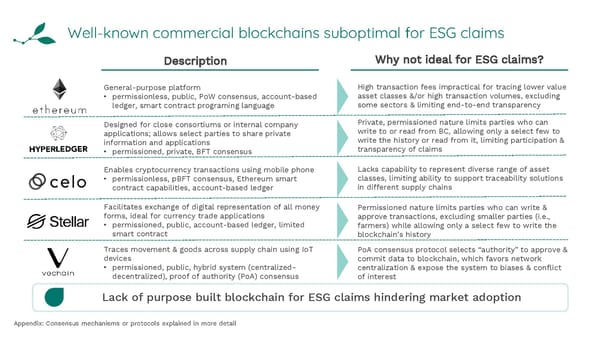Well-known commercial blockchains suboptimal for ESG claims Description Why not ideal for ESG claims? General-purpose platform High transaction fees impractical for tracing lower value • permissionless, public, PoW consensus, account-based asset classes &/or high transaction volumes, excluding ledger, smart contract programing language some sectors & limiting end-to-end transparency Designed for close consortiums or internal company Private, permissioned nature limits parties who can applications; allows select parties to share private write to or read from BC, allowing only a select few to information and applications write the history or read from it, limiting participation & • permissioned, private, BFT consensus transparency of claims Enables cryptocurrency transactions using mobile phone Lacks capability to represent diverse range of asset • permissionless, pBFT consensus, Ethereum smart classes, limiting ability to support traceability solutions contract capabilities, account-based ledger in different supply chains Facilitates exchange of digital representation of all money Permissioned nature limits parties who can write & forms, ideal for currency trade applications approve transactions, excluding smaller parties (i.e., • permissioned, public, account-based ledger, limited farmers) while allowing only a select few to write the smart contract blockchain’s history Traces movement & goods across supply chain using IoT PoA consensus protocol selects “authority” to approve & devices commit data to blockchain, which favors network • permissioned, public, hybrid system (centralized- centralization & expose the system to biases & conflict decentralized), proof of authority (PoA) consensus of interest Lack of purpose built blockchain for ESG claims hindering market adoption Appendix: Consensus mechanisms or protocols explained in more detail
 The ESG Blockchain | Topl Page 11 Page 13
The ESG Blockchain | Topl Page 11 Page 13